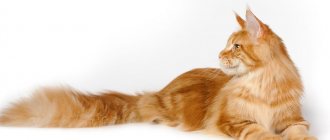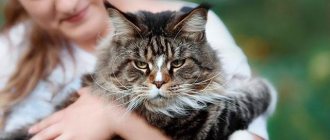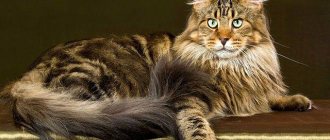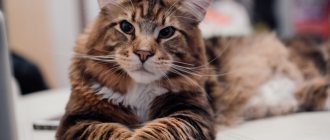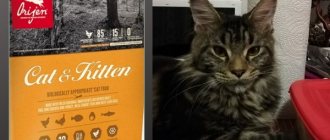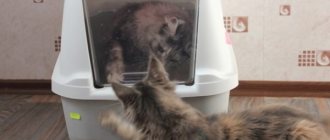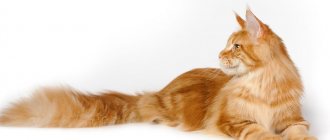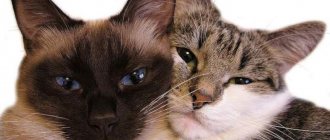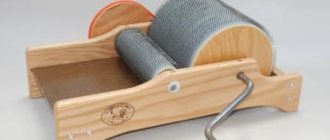The health status of an adult cat is determined by various criteria - from the animal’s behavior to the quality of its fur. But some diseases cannot be detected by external signs. For example, the correct development of a Maine Coon kitten can be judged by how much it weighs. Therefore, a responsible owner must carefully monitor the growth of his pet using special tables.
Size standards and maximum weight
These animals are rightfully considered the largest domestic cats among those breeds that are able to live with humans without any problems. All four-legged champions and record holders for weight and height are Maine Coons. They have significantly outgrown the rest of their competitors. The average weight of representatives of this breed is 8-10 kg for males and 4-7 kg for females.
Like other native species, big Manx cats mature late. They enter a sexually mature state quite quickly - females can give birth to offspring already at the age of 7-9 months, but Maine Coons grow up to 4-5 years.
At the age of 5 years, the weight of a Maine Coon cat remains almost unchanged. As soon as a pet loses its appetite, loses weight and becomes lethargic (even in the absence of other signs of illness), it needs to be shown to a veterinarian in order to exclude the development of diseases, which often pass in a latent chronic form, but necessarily manifest themselves in later stages.
This is interesting! A cat named Omar became a contender for entry into the Guinness Book of Records. By the end of the first year of his life, he had already gained 10 kg, and later each year he added one more. Now the title candidate is 4 years old, the actual body length of this Maine Coon is 1.2 meters and, standing on his hind legs, he can easily take food from the dinner table.
Symptoms of animal discomfort
A cat has a belly button: do cats have it, why not?
In itself, if a cat’s belly hangs in the area of its hind legs, it does not become a sign of some kind of illness. On the other hand, you should think about it if the fat tail causes discomfort to the animal.
The presence of discomfort is usually accompanied by the following symptoms:
- It hurts the animal if you touch its stomach. The cat begins to meow pitifully and tries with all his might to avoid contact with human hands;
- There are a number of movement restrictions. The cat cannot or does not even try to jump somewhere, refuses to play or run;
- The pet's belly has a significant external difference. Red or blue spots appear;
- hair loss is observed. Noticeable bald spots appear on the stomach;
- refusal to eat, weight loss of the animal, vomiting, diarrhea;
- general deterioration in the condition and health of the pet.
What is the weight of an adult Maine Coon: the difference between a cat and a cat
In adult Maine Coons, there are significant differences between the weight and height of male and female cats:
- Cats are heavier and longer. A 3-month-old Maine Coon should weigh more than 2 kg, a one-year-old - from 6 to 8.5 kg. Castrated males traditionally exceed the average by another 2-3 kg. This is due to the lack of sexual activity.
- Cats are always smaller and more graceful than males. At 3 months they should weigh about 2 kg, and by the year they gain on average up to 5 kg. As adults, sterilized cats “eat” another 3 kg.
Most often, the weight of an adult Maine Coon cat is around 6-7 kg. Veterinarians do not recommend going beyond these averages, and in case of overeating or weight gain for other reasons, the animal is prescribed a gentle diet or fasting days.
Other differences between a cat and a female cat are in the area of external characteristics that do not depend on the size to which the Maine Coon grows.
Important! Felinologists have compiled a special monthly weight table for Maine Coons. Deviation from it means the presence of problems with health and general development.
Signs of a pathological condition
Dog walking area: norms and rules
The main pathological signs are a significant increase in the abdomen and the presence of hard formations. A fat belly is not a symptom, but an increase and thickening of this area can indicate a number of abnormalities. Among them:
- constipation;
- increased gas formation;
- disruption of the liver and kidneys;
- neoplasms;
- violation of the integrity of the bladder;
- problems with the digestive tract;
- inguinal hernia;
- in females the manifestation of mastitis, which can only be removed by surgical intervention;
- a dead fetus located in the uterus, which will also need to be removed through surgery.
Important! If the owner of the animal notices abnormal behavior for his pet, loss of appetite or lumps in the abdomen, this becomes a reason to visit the veterinarian.
Maine Coon weight by month
Newborn Maine Coon kittens weigh from 120 to 180 grams, although very small (80 g) animals are often viable. Experts distinguish 2 initial stages of kitten growth:
- Neonatal cycle – first 4 days. At this time, development is highly dependent on the complexity of labor and birth order.
- Sucking month. The only food for the baby is mother's milk and in any case adds at least 10 g to the baby's weight every day. But the normal value is 5-8 times more (50-80 g/day).
Girls weight
The average weight of a newborn cat is 100-150 g.
- In the first month of life, this figure reaches 600-700 g. Small cats can weigh 0.55 kg, and larger individuals can weigh up to 0.75 kg.
- At 2 months the values double again - 1.0-1.55 kg.
- At 3 months, a Maine Coon (girl) should already weigh 1.5 - 2.3 kg and then add about 40% of total body weight every 30 days.
By 6 months (3-4 kg), active weight gain stops - now before a year, cats will gain another half weight and should weigh from 4.5 to 6 kg. At this age, Maine Coon girls grow more slowly than boys.
Boys weight
The average weight of a newborn male is 150 g. In the first weeks of life, the baby should gain about 40% in weight. At the age of 1 month, a Maine Coon kitten should weigh 0.7-0.8 kg.
Then the cat’s body weight increases evenly. At 4 months the weight of a Maine Coon is about 4 kg. Every next 30 days brings an additional kilogram. It's very easy to remember. At 5 months, the Maine Coon weighs 5-6 kg, at 6 months – 6-7 kg, and at 7 months, the Maine Coon should still weigh the same 6-7 kg (or a little more), because the period of active growth has ended.
By the year the cat will add a couple more kilograms, and all further records will be set only closer to the stage of full adulthood - after 3 years.
Table
Maine Coon weight by month (feline and male development chart):
| Age | Boys (kg) | Girls (kg) |
| At birth | 0,15-0,18 | 0,12-0,15 |
| 1 Week | 0,2-0,25 | 0,2-0,25 |
| 2 weeks | 0,3-0,35 | 0,3-0,35 |
| 3 weeks | 0,45-0,5 | 0,4-0,45 |
| 1 month | 0,65-0,8 | 0,55-0,65 |
| 2 months | 1,2-1,5 | 1,0-1,3 |
| 3 months | 1,9-2,4 | 1,5-2,0 |
| 4 months | 3,3-3,8 | 2,8-3,3 |
| 5 months | 4,0-5,5 | 3,5-4,0 |
| 6 months | 5,0-6,5 | 4,0-4,5 |
| 1 year | 6,0-9,0 | 5,0-6,5 |
| 2 years | up to 10.0 | up to 7 |
| 3 years | 12,0-13,0 | 7,5-8,0 |
*All data on the weight of small Maine Coon kittens should be considered as an example only. The development of animals depends on the conditions of detention, nutrition, physical activity, health and other factors.
Maine Coon height and weight by month
Unlike the table of a kitten’s weekly (monthly) weight gain, none of the experts describes the growth of the Maine Coon in detail. In fact, the development of the animal occurs unevenly - during the first weeks the cat really quickly increases in size and overtakes its outbred peers.
Also, a lot depends on the conditions of detention - an active Maine Coon, not limited in movement and games, always develops better than pets who live in more modest conditions. But later nature will put everything in its place.
The dimensions of an adult Maine Coon are approximately the same. Its length is about 1 m, and its height at the withers is 30-35 cm. Giants grow up to 40 cm or more, but these are truly rare specimens. Sometimes they try to compare the size of an adult cat with the height of a person (child), but this is completely wrong. The length of the Maine Coon takes into account the parameters “from tip to tip” (nose to tail), and its body is not so impressive. At 8 months, the Maine Coon's weight approaches 7-8 kg, and its height already allows it to rise on its hind legs and take food from the table.
This is interesting! Champion Maine Coons allegedly grew up to 1.35 m in length, but such rumors have not been officially recorded anywhere. And the current record holder has impressive dimensions - his height of 123 cm is confirmed by the Guinness Book of Records.
How old do Maine Coons grow?
Maine Coons grow up to 5 years old. In some individuals, this process is completed earlier - it all depends on the conditions of detention, nutrition and genetic data of the cat. For example, the table indicates that at 3 months a Maine Coon should weigh 2-2.4 kg, but the scales show the owner other, lower numbers. If the baby is healthy, then there is no need to worry - over time, the Maine Coon will gain the missing kilograms.
In Maine Coon cats, monthly weight gain may also differ from the data indicated in the table. Most often this happens closer to the year, when females enter the puberty phase. At this time, all efforts are devoted to the formation of internal organs, and growth slows down. Later, after the first mating, the cat can quickly recover and even grow.
Important! An indirect indicator of how big a Maine Coon will grow is its parents. Large offspring are always born from equally tall and heavy male cats.
Treatment
So, all cats have a primordial sac. If it sags by about 3-5 cm, this is considered normal. If there are no other symptoms of the animal's disease, there is no need to worry.
It is necessary to take action only if the total weight of the pet significantly exceeds the norm. You should weigh your pet and compare the data with the height and weight standards established for this breed.
You can also determine obesity yourself: you need to look at the cat from above, and then feel its sides. When palpating, the ribs should be palpable, and the stomach should not stick out to the sides.
You may be interested in: How to protect a cat from toxoplasmosis: routes of infection, symptoms, treatment and prevention.
Obesity negatively affects the functioning of all internal organs of the animal. It can lead to a number of dangerous diseases. Therefore, an animal that has been diagnosed with obesity needs to be put on a diet.
In this case, special low-calorie foods are perfect. In addition, be sure to follow the portion size indicated on the package of food.
You should not feed the animal on demand. It is imperative to follow the feeding schedule.
You should also keep the animal on a diet immediately after sterilization. Due to hormonal imbalances, cats often begin to eat a lot, which is why their weight rapidly increases.
Increasing physical activity is also helpful for weight loss. You need to play with the cat more. If all required vaccinations have been completed, the animal can be taken outside on a leash.
If any disease has caused the enlargement of the primordial sac, the doctor may use conservative or surgical treatment methods. In some cases, the animal will have to be transferred to a hospital.
Why is my cat not growing or losing weight?
The main reasons that affect weight loss or slow growth of a Maine Coon include:
- Small Maine Coon kittens, which are the last born in the litter, usually weigh less and cannot compete for mother's milk on an equal basis with the rest - owners have to carefully monitor that each cub receives its portion of food.
- The weight of a Maine Coon may differ by 10-20% from the weight indicated in the tables and there is nothing to worry about. But if the situation does not change over a long period of time, then you should contact a veterinarian.
- Timely treatment for external and internal parasites reduces the risk of weight loss in Maine Coons.
- In the formation of a Maine Coon, its lifestyle plays an important role - active games and appropriate physical activity help improve the growth of the animal.
A healthy Maine Coon always grows to 5-8 kg, and further weight gain will depend on the conditions of the cat’s keeping and nutrition.
Causes of exhaustion
Exhaustion, or cachexia, develops under the influence of exogenous (external) and endogenous (internal) factors.
Exogenous
Exogenous external causes of exhaustion include:
- lack of food (emaciation is observed in feral cats and animals that receive food from time to time);
- impaired swallowing functions (the cat has something stuck in its throat, the nasopharynx is inflamed due to an insect bite, under the influence of allergens);
- problems with teeth (inflammation in the oral cavity, caries, tartar - all this prevents the animal from eating its usual food).
Natural Cause of Thinness
An adult cat should receive at least 70 g of dry food per day. If the cat is nursing offspring or is sick, the norm is doubled. At the same time, there should always be only fresh food in the bowl, as many food manufacturers warn about.
Endogenous
Endogenous (internal) factors that provoke cachexia include diseases of a non-infectious and infectious nature. Cats lose weight due to the development of:
- oncological diseases;
- cardiovascular pathologies;
- diabetes mellitus;
- chronic infections (infectious peritonitis, immunodeficiency, leukemia).
Cachexia is caused by hormonal disorders, problems with the pancreas, dysfunction of the kidneys, liver, and pituitary gland.
Sometimes weight loss occurs due to:
- the occurrence of a stressful situation (if the cat is given into the wrong hands, often transported);
- bearing offspring and feeding kittens (nursing cats often become excessively thin, so that a thin cat does not become completely exhausted and gets sick, kittens are weaned as soon as they begin to feed on their own);
- vitamin deficiency (feed must be balanced, it is useful to give the cat additional vitamins);
- formation of hairballs in the stomach (from time to time pets are given special tablets to cough it up);
- infection of the pet’s body with helminths (parasites release dangerous toxins, weaken the cat, their activity over time leads to physical pain, which causes apathy and loss of appetite).
An adult, non-castrated cat loses weight when the heat begins. In the spring, cats literally forget about everything in the world, including food, they move a lot and eat poorly, so they lose weight. Females also lose weight for this reason, but it is males who experience significant changes.
Important! Older cats move less, sleep a lot and, accordingly, eat less, which affects their body weight.
What to do if your cat is not gaining weight
During the first two months of life, a young Maine Coon's weight should be monitored weekly. Any prolonged deviation from the norm becomes a reason for a visit to the veterinarian.
Throughout each year of an adult Maine Coon's life, its weight is monitored. At the same time, excess weight is also dangerous for the health of the animal.
The big cat sometimes becomes capricious, refuses food and even loses weight. If it comes to the nature of the Maine Coon, then you can give the cat fasting days, and after that gradually change the diet. However, a prolonged departure from the weight gain schedule is an alarming sign that may indicate the development of a serious pathology in the animal’s body. In this case, the cat needs to be taken to the vet immediately.
But most often, representatives of the Maine Coon breed have good health, excellent genetics and powerful immunity. They are sociable and do not require special conditions. All the future giant needs is the love and attention of its owner, and the strong cat will definitely gain weight.
